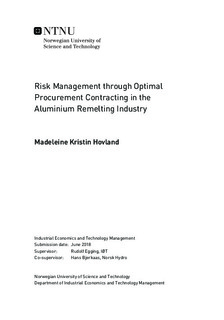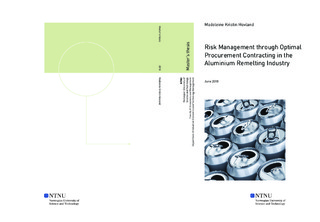| dc.description.abstract | In today s increasingly turbulent and volatile commodity exchange markets, it is evident that controlling the risks in procurement strategies is an important issue. In this thesis, we develop a portfolio procurement optimisation model handling a Procurement Hedging Strategy Problem (PHSP). The portfolio optimisation problem has been one of the important research fields in modern risk management and there has been a growing interest in Conditional Value at Risk (CVaR) as a financial risk measurement tool in portfolio optimisation. This interest is based on many key advantages of CVaR compared with the more used measures of risk: standard deviation (SD) and Value-at-Risk (VaR).
Aluminium remelters participating in the European scrap market face significant uncertainty in future spot prices. While facing this risk, a remelter selects a procurement portfolio of scrap contracts with different maturities and prices to satisfy the expected material usage. The procurement strategy is also created in accordance with the decision maker s level of risk aversion. The methods described in this thesis will be useful as a decision support tool for determining risk management and hedging strategies in the aluminium remelting business.
Taking the view of a single risk-averse producer, namely Holmestrand Rolling Mill (i.e. Norsk Hydro ASA), we propose a multistage stochastic model for the coordination of inventory and procurement, while considering uncertainty in the spot prices of aluminium. The presented model focuses on minimising a combination of expected cost and CVaR. Although the basis of the model is a standard CVaR approach, the model is further developed in a nested fashion, using recursive constraints, to handle time-inconsistency issues. Numerical results are presented for a six-stage, 256 scenario data instance with a one year horizon, and are based on data from Norsk Hydro and listed indexes on London Metal Exchange.
The model is tested to demonstrate its application as a decision-making tool in practice. An assessment of the applicability and validity of the model is made based on several test instances. Results show that instances of considerable size are challenging to solve due to the model s complexity. Nevertheless, optimal solutions can be found within a reasonable time frame for Holmestrand Rolling Mill. Moreover, findings prove the model s ability to suggest hedging strategies according to the decision maker s level of risk aversion. That is, the results show that hedging with the use of forward contracts reduces the risk in terms of CVaR. The percentage procurement through forward contracts vary between 46.21 % to 60.53 % depending on risk preferences and test cases, demonstrating diversification and hedging. The degree of risk-aversion also influences the maturity of the chosen long-term contracts: the higher the degree of risk aversion, the longer the maturity of the forward contracts. The model also demonstrates the ability to adjust the procurement strategy for different price data by shifting towards long-term contracts for increased price variation and scheduling more material purchase when the average prices are lower. | |

